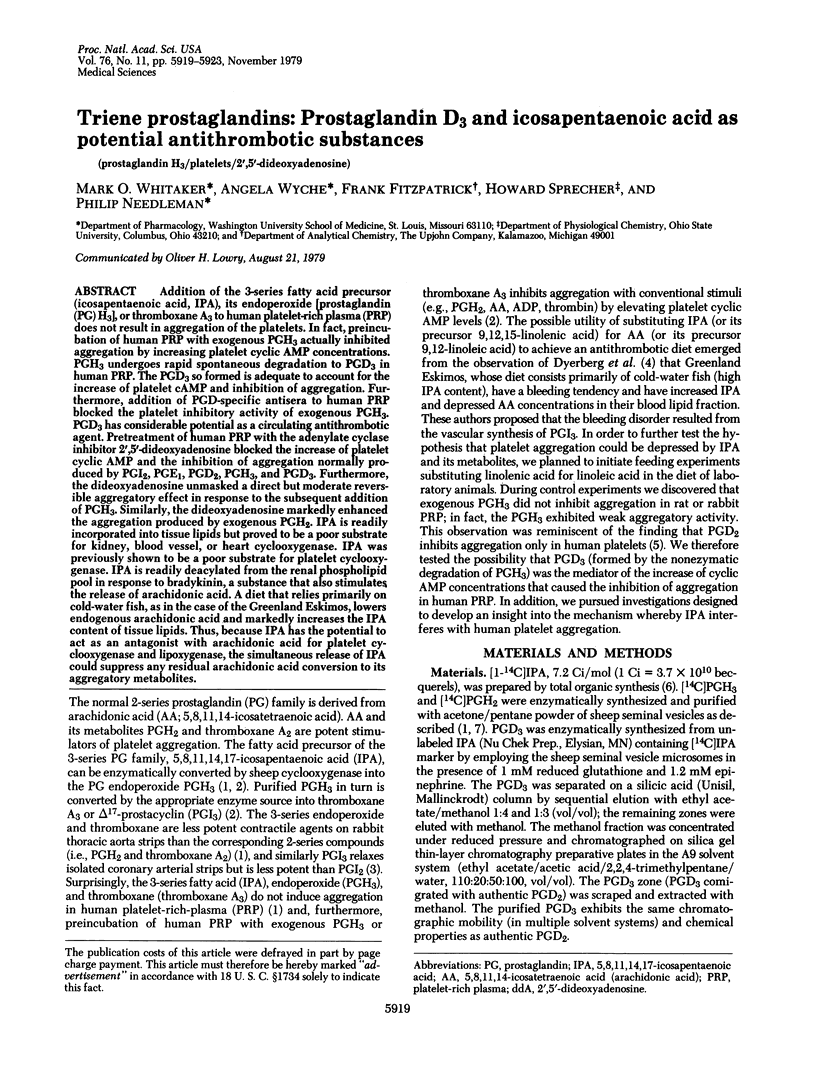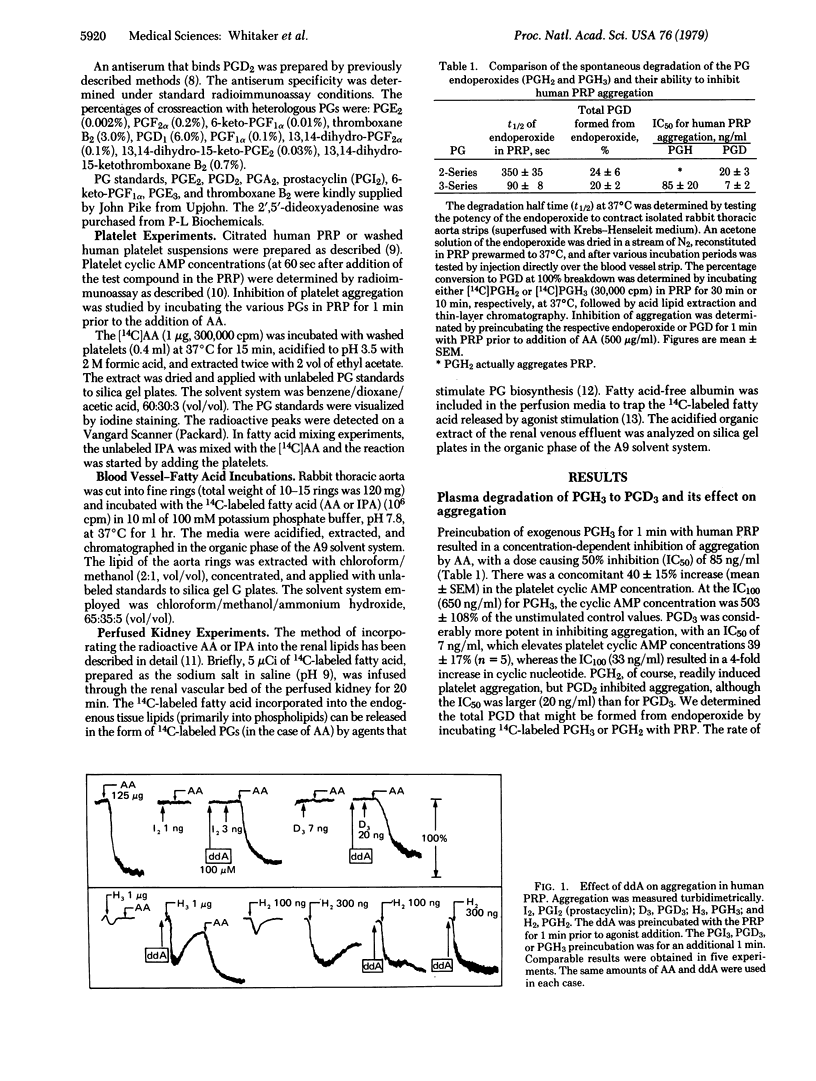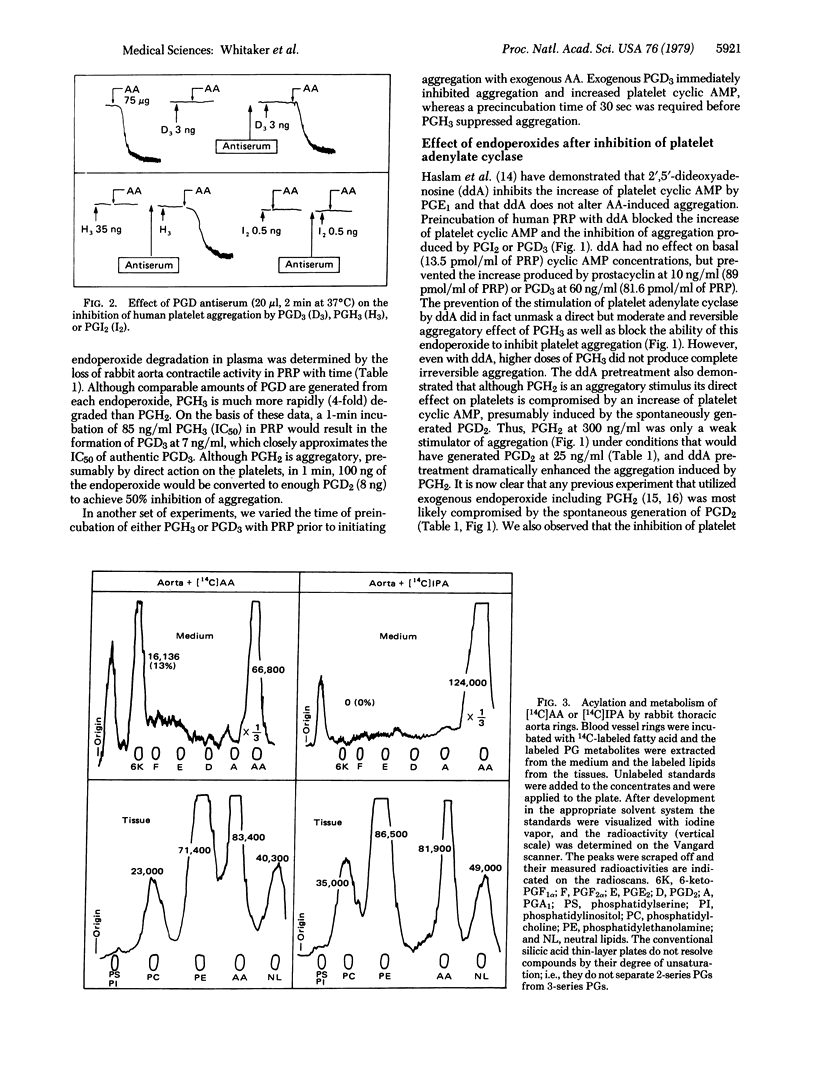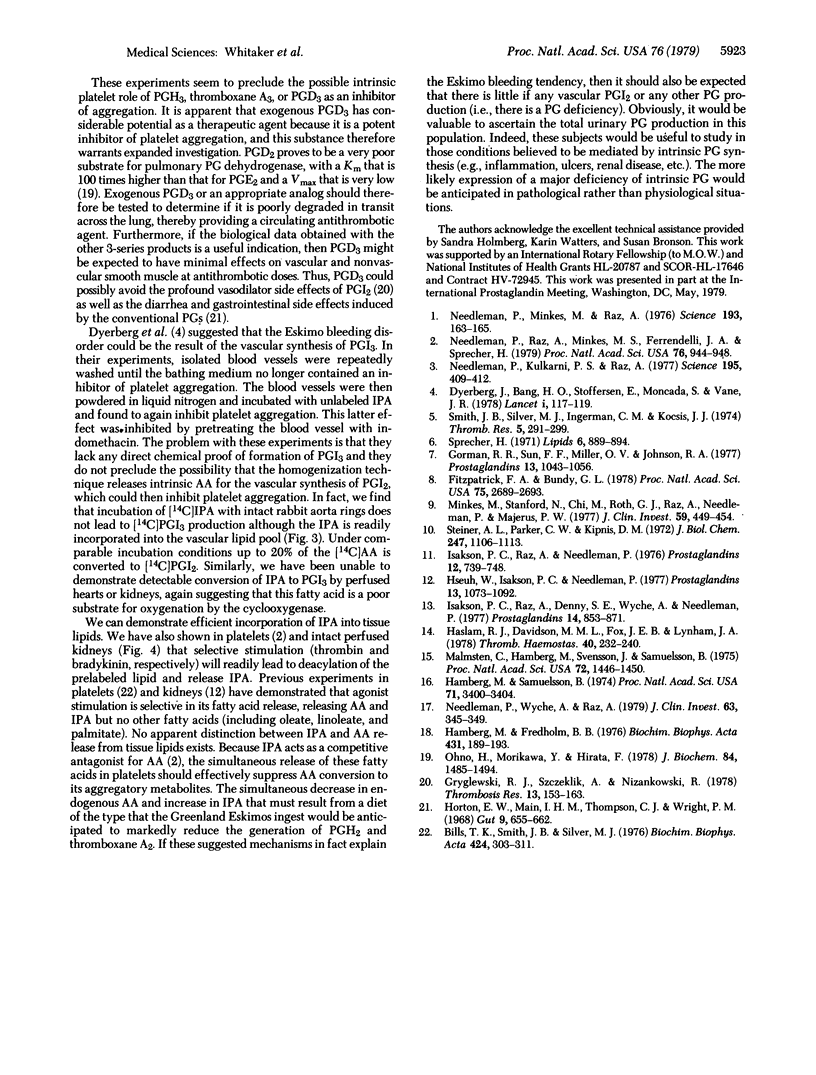Abstract
Addition of the 3-series fatty acid precursor (icosapentaenoic acid, IPA), its endoperoxide [prostaglandin (PG)H3], or thromboxane A3 to human platelet-rich plasma (PRP) does not result in aggregation of the platelets. In fact, preincubation of human PRP with exogenous PGH3 actually inhibited aggregation by increasing platelet cyclic AMP concentrations. PGH3 undergoes rapid spontaneous degradation to PGD3 in human PRP. The PGD3 so formed is adequate to account for the increase of platelet cAMP and inhibition of aggregation. Furthermore, addition of PGD-specific antisera to human PRP blocked the platelet inhibitory activity of exogenous PGH3. PGD3 has considerable potential as a circulating antithrombotic agent. Pretreatment of human PRP with the adenylate cyclase inhibitor 2′,5′-dideoxyadenosine blocked the increase of platelet cyclic AMP and the inhibition of aggregation normally produced by PGI2, PGE1, PGD2, PGH3, and PGD3. Furthermore, the dideoxyadenosine unmasked a direct but moderate reversible aggregatory effect in response to the subsequent addition of PGH3. Similarly, the dideoxyadenosine markedly enhanced the aggregation produced by exogenous PGH2. IPA is readily incorporated into tissue lipids but proved to be a poor substrate for kidney, blood vessel, or heart cyclooxygenase. IPA was previously shown to be a poor substrate for platelet cyclooxygenase. IPA is readily deacylated from the renal phospholipid pool in response to bradykinin, a substance that also stimulates the release of arachidonic acid. A diet that relies primarily on cold-water fish, as in the case of the Greenland Eskimos, lowers endogenous arachidonic acid and markedly increases the IPA content of tissue lipids. Thus, because IPA has the potential to act as an antagonist with arachidonic acid for platelet cyclooxygenase and lipoxygenase, the simultaneous release of IPA could suppress any residual arachidonic acid conversion to its aggregatory metabolites.
Keywords: prostaglandin H3; platelets; 2′,5′-dideoxyadenosine
Full text
PDF




Selected References
These references are in PubMed. This may not be the complete list of references from this article.
- Bills T. K., Smith J. B., Silver M. J. Metabolism of [14C]arachidonic acid by human platelets. Biochim Biophys Acta. 1976 Feb 23;424(2):303–314. doi: 10.1016/0005-2760(76)90198-3. [DOI] [PubMed] [Google Scholar]
- Dyerberg J., Bang H. O., Stoffersen E., Moncada S., Vane J. R. Eicosapentaenoic acid and prevention of thrombosis and atherosclerosis? Lancet. 1978 Jul 15;2(8081):117–119. doi: 10.1016/s0140-6736(78)91505-2. [DOI] [PubMed] [Google Scholar]
- Fitzpatrick F. A., Bundy G. L. Hapten mimic elicits antibodies recognizing prostaglandin E2. Proc Natl Acad Sci U S A. 1978 Jun;75(6):2689–2693. doi: 10.1073/pnas.75.6.2689. [DOI] [PMC free article] [PubMed] [Google Scholar]
- Gorman R. R., Sun F. F., Miller O. V., Johnson R. A. Prostaglandins H1 and H2. Convenient biochemical synthesis and isolation. Further biological and spectroscopic characterization. Prostaglandins. 1977 Jun;13(6):1043–1053. doi: 10.1016/0090-6980(77)90132-0. [DOI] [PubMed] [Google Scholar]
- Gryglewski R. J., Szczeklik A., Nizankowski R. Anti-platelet action of intravenous infusion of prostacyclin in man. Thromb Res. 1978 Aug;13(2):153–163. doi: 10.1016/0049-3848(78)90004-x. [DOI] [PubMed] [Google Scholar]
- Hamberg M., Fredholm B. B. Isomerization of prostaglandin H2 into prostaglandin D2 in the presence of serum albumin. Biochim Biophys Acta. 1976 Apr 22;431(1):189–183. doi: 10.1016/0005-2760(76)90273-3. [DOI] [PubMed] [Google Scholar]
- Hamberg M., Samuelsson B. Prostaglandin endoperoxides. Novel transformations of arachidonic acid in human platelets. Proc Natl Acad Sci U S A. 1974 Sep;71(9):3400–3404. doi: 10.1073/pnas.71.9.3400. [DOI] [PMC free article] [PubMed] [Google Scholar]
- Haslam R. J., Davidson M. M., Fox J. E., Lynham J. A. Cyclic nucleotides in platelet function. Thromb Haemost. 1978 Oct 31;40(2):232–240. [PubMed] [Google Scholar]
- Horton E. W., Main I. H., Thompson C. J., Wright P. M. Effect of orally administered prostaglandin E1 on gastric secretion and gastrointestinal motility in man. Gut. 1968 Dec;9(6):655–658. doi: 10.1136/gut.9.6.655. [DOI] [PMC free article] [PubMed] [Google Scholar]
- Hsueh W., Isakson P. C., Needleman P. Hormone selective lipase activation in the isolated rabbit heart. Prostaglandins. 1977 Jun;13(6):1073–1091. doi: 10.1016/0090-6980(77)90135-6. [DOI] [PubMed] [Google Scholar]
- Isakson P. C., Raz A., Denny S. E., Wyche A., Needleman P. Hormonal stimulation of arachidonate release from isolated perfused organs. Relationship to prostaglandin biosynthesis. Prostaglandins. 1977 Nov;14(5):853–871. doi: 10.1016/0090-6980(77)90302-1. [DOI] [PubMed] [Google Scholar]
- Isakson P. C., Raz A., Needleman P. Selective incorporation of 14C-arachidonic acid into the phospholipids of intact tissues and subsequent metabolism to 14C-prostaglandins. Prostaglandins. 1976 Nov;12(5):739–748. doi: 10.1016/0090-6980(76)90049-6. [DOI] [PubMed] [Google Scholar]
- Malmsten C., Hamberg M., Svensson J., Samuelsson B. Physiological role of an endoperoxide in human platelets: hemostatic defect due to platelet cyclo-oxygenase deficiency. Proc Natl Acad Sci U S A. 1975 Apr;72(4):1446–1450. doi: 10.1073/pnas.72.4.1446. [DOI] [PMC free article] [PubMed] [Google Scholar]
- Minkes M., Stanford N., Chi M. M., Roth G. J., Raz A., Needleman P., Majerus P. W. Cyclic adenosine 3',5'-monophosphate inhibits the availability of arachidonate to prostaglandin synthetase in human platelet suspensions. J Clin Invest. 1977 Mar;59(3):449–454. doi: 10.1172/JCI108659. [DOI] [PMC free article] [PubMed] [Google Scholar]
- Needleman P., Kulkarni P. S., Raz A. Coronary tone modulation: formation and actions of prostaglandins, endoperoxides, and thromboxanes. Science. 1977 Jan 28;195(4276):409–412. doi: 10.1126/science.831285. [DOI] [PubMed] [Google Scholar]
- Needleman P., Minkes M., Raz A. Thromboxanes: selective biosynthesis and distinct biological properties. Science. 1976 Jul 9;193(4248):163–165. doi: 10.1126/science.945611. [DOI] [PubMed] [Google Scholar]
- Needleman P., Raz A., Minkes M. S., Ferrendelli J. A., Sprecher H. Triene prostaglandins: prostacyclin and thromboxane biosynthesis and unique biological properties. Proc Natl Acad Sci U S A. 1979 Feb;76(2):944–948. doi: 10.1073/pnas.76.2.944. [DOI] [PMC free article] [PubMed] [Google Scholar]
- Needleman P., Wyche A., Raz A. Platelet and blood vessel arachidonate metabolism and interactions. J Clin Invest. 1979 Feb;63(2):345–349. doi: 10.1172/JCI109309. [DOI] [PMC free article] [PubMed] [Google Scholar]
- Ohno H., Morikawa Y., Hirata F. Studies on 15-hydroxyprostaglandin dehydrogenase with various prostaglandin analogues. J Biochem. 1978 Dec;84(6):1485–1494. doi: 10.1093/oxfordjournals.jbchem.a132272. [DOI] [PubMed] [Google Scholar]
- Smith J. B., Silver M. J., Ingerman C. M., Kocsis J. J. Prostaglandin D2 inhibits the aggregation of human platelets. Thromb Res. 1974 Sep;5(3):291–299. doi: 10.1016/0049-3848(74)90168-6. [DOI] [PubMed] [Google Scholar]
- Sprecher H. The synthesis of 1-14C-arachidonate and 3-14C-docosa-7,10,13,16-tetraenoate. Lipids. 1971 Dec;6(12):889–894. doi: 10.1007/BF02531170. [DOI] [PubMed] [Google Scholar]
- Steiner A. L., Parker C. W., Kipnis D. M. Radioimmunoassay for cyclic nucleotides. I. Preparation of antibodies and iodinated cyclic nucleotides. J Biol Chem. 1972 Feb 25;247(4):1106–1113. [PubMed] [Google Scholar]


